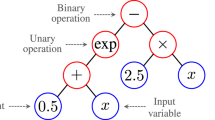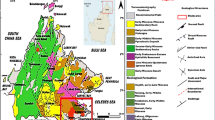Abstract
Geologic surface interpolations can be augmented by adding physical constraints to available data. Here a method is outlined that allows one to constrain surface interpolations for two geologic surfaces based on the apparent thickness of the bounded layer. The resulting interpolation scheme is posed as a quadratic programming in which the interpolation of each surface is solved approximately and subject to linear constraints on the apparent thickness. Results can be further improved by adding cubic polynomials to the interpolating functions to regularize the problem. In one-dimensional interpolations of geologic folds, the method improves the results over unconstrained interpolations by eliminating interpenetrations (negative apparent thicknesses) and regions of small apparent thicknesses. In a two-dimensional application for the monocline at Raplee Ridge, UT, the capability of this method is illustrated by overcoming interpenetration of two surfaces, the tops of the Mendenhall oil sand and the Unnamed limestone. The minimum curvature spline interpolation is applied to topographic data taken from an airborne laser swath mapping (ALSM) survey and interpolated by detailed geologic mapping. This method can be extended to allow for multiple layers.
Similar content being viewed by others
References
Briggs I (1974) Machine contouring using minimum curvature. Geophysics 39(1):39–48
Caers J (2000) Adding local accuracy to direct sequential simulation. Math Geol 32(7):815–850
Dirkse S, Ferris M (1995) The PATH solver: a non-monotone stabilization scheme for mixed complementarity problems. Optim Methods Softw 5:123–156
Dubrule O, Kostov C (1986) An interpolation method taking into account inequality constraints: I. Methodology. Math Geol 18(1):33–51
Ferris M, Kanzow C, Munson T (1999) Feasible decent algorithms for mixed complementarity problems. Math Program 86(3):475–497
Gill P, Murray W, Wright M (1981) Practical optimization. Academic, New York. 401 p
Goovaerts P (1997) Geostatistics for natural resource evaluation. Oxford University Press, New York. 496 p
Gregory H, Moore R (1931) The Kaiparowits regions, a geographic and geologic reconnaissance of parts of Utah and Arizona. US Geol Surv Prof Paper, 164
Kimeldorf G, Wahba G (1971) Some results on Tchebycheffian spline functions. J Math Anal Appl 33(1):82–95
Kirkland D, Anderson R (1970) Microfolding in the Castile and Todilto evaporites, Texas and New Mexico. Geol Soc Am Bull 81:3259–3282
Kostov C, Dubrule O (1986) An interpolation method taking into account inequality constraints: II. Practical approach. Math Geol 18(1):53–73
Mallet JL (1989) Discrete smooth interpolation. ACM Trans Graph 8(2):121–144
Mansfield E (1989) The bending and stretching of plates. Cambridge, New York. 228 p
Matheron G (1981) Splines and kriging: Syracuse University. Geol Contrib 8:77–95
Mitás̆ová H, Mitás̆ L (1993) Interpolation by regularization spline with tension: I. Theory and implementation. Math Geol 25(6):641–655
Mynatt I, Hilley G, Pollard D (2007) Inferring fault characteristics using fold geometry constrained by airborne laser swath mapping at Raplee Ridge, UT. Geophys Res Lett 34:L16315. doi:10.1029/2007GL030548
Nocedal J, Wright S (2006) Numerical optimization. Springer, New York. 636 p
O’Sullivan R (1965) Geology of the Cedar Mesa-Boundary Butte area, San Juan County, Utah. US Geol Surv Bull B1186:1–128
Ralph D (1994) Global convergence of damped Newton’s method for nonsmooth equation via the PATH search. Math Oper Res 19(2):352–389
Sandwell DT (1987) Biharmonic spline interpolation of GEOS-3 and SEASAT altimeter data. Geophys Res Lett 14(2):139–142
Smith W, Wessel P (1990) Gridding with continuous curvature splines in tension. Geophysics 55(3):293–305
Szilard R (2004) Theories and applications of plate analysis: classical, numerical and engineering methods. Wiley, Hoboken. 1056 p
Timoshenko S, Woinowsky-Krieger S (1968) Theory of plates and shells. McGraw-Hill, New York. 580 p
Wahba G (1978) Improper priors, spline smoothing and the problem of guarding against model errors in regression. J R Stat Soc 40(3):364–372
Watson G (1984) Smoothing and interpolations by kriging and with splines. Math Geol 16(6):601–615
Wessel P, Bercovici D (1998) Interpolation with splines in tension: a Green’s function approach. Math Geol 30(1):77–93
Author information
Authors and Affiliations
Corresponding author
Rights and permissions
About this article
Cite this article
Kaven, J.O., Mazzeo, R. & Pollard, D.D. Constraining Surface Interpolations Using Elastic Plate Bending Solutions with Applications to Geologic Folding. Math Geosci 41, 1–14 (2009). https://doi.org/10.1007/s11004-008-9201-5
Received:
Accepted:
Published:
Issue Date:
DOI: https://doi.org/10.1007/s11004-008-9201-5




